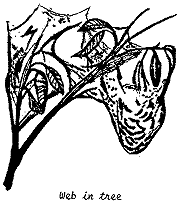|
INJURY: Damage is usually not severe as fall webworms are seldom
numerous enough to cause total defoliation. When they are
present in large numbers the damage is still not serious
because these insects are late season feeders and by the
time the leaves are consumed the leaves have already
performed most of their function to the plant. The webbing
which may persist after leaf drop, however, is unsightly.
DESCRIPTION:

The larvae of the fall webworm feed on more than 100 species
of fruit, shade and forest trees and are especially
noticeable during the late summer and early fall. The larvae
spin conspicuous webs enclosing entire branches or groups of
branches. The webs are more numerous in open locations such
as along roadsides. Larvae feed inside the webs stripping
the leaves with just the mid-vein remaining.
The larvae are quite hairy, and range in color from light buff green
to near black. Both color forms may be present in a local area. The
adults are one of our common tiger moths, white, sometimes with dark
spots on the wings.
LIFE HISTORY:
There may be two broods of the fall webworm each year in some areas
of New York State. The first brood occurs in May but is small and
often goes unnoticed. The main brood occurs during July and August,
and is larger than the first.
Eggs are laid in hair-covered masses on the undersides of leaves
from May to August. The eggs hatch and the tiny larvae start building
a web enclosing a few leaves. As they grow, they expand the web
covering more foliage and thus encompassing more food. The larvae
leave the web in the last instar, crawl down the tree trunk or spin
down and pupate in a thin cocoon spun in the debris at soil surface
or just below soil surface.
Back to Pest Information
|
|

INJURY:
Adult flea beetles feed on the leaves of cabbage, tomato, tobacco,
potato, cucumber, melon, grape, spinach, eggplant and related crops.
They chew many holes in the leaves and a heavily infested plant may
look as if small shots had been fired into it. The foliage may be
very badly eaten on many garden plants causing the plants to die.
Larvae feed on the roots and tubers of the host plants. In most cases
different kinds of flea beetles attack only closely related plants,
but some are general feeders.
DESCRIPTION:
The adult flea beetle is small - 1/16 to 1/5 inch long, oval in
shape, and it varies in color from blue-green to black. These small
jumping beetles have the hind femora enlarged. The larvae are
delicate, whitish, slender cylindrical worms, not over 1/3 inch long
with brownish heads and long legs.
LIFE HISTORY:
After mating in the late spring, the female beetle enters the soil
near the base of the food plant to lay her eggs. The eggs hatch in 5
to 8 days. The larvae feed on the roots for 2 to 3 weeks. When the
larvae are mature they enter the inactive pupal stage for 10-14 days.
Adults emerge and a second generation begins and sometimes even a
third. The insect overwinters as an adult in the soil and emerges
again in May or June to begin feeding on the next season's crops.
Back to Pest Information
|
|
|
|
DESCRIPTION AND INJURY: |
BEHAVIOR AND ECOLOGY:
:Each species of flea has one or two kinds of animals it prefers,
although when hungry, it will attack a wide variety of warm blooded
animals sometimes including humans.
Cat and dog fleas periodically jump on and off the host. When the host is removed for a period of time, they are left without food. Hungry adult fleas often attack the first warm blooded animal that comes in the door, often biting people around the ankles. In addition to adult fleas present at the time, vibrations are known to cause, at least in part, the emergence of new adults from pupae. Walking across the floor may trigger emergence. Adult fleas live on the blood of the animals, and must have a blood meal to reproduce.
LIFE HISTORY:
Female fleas lay eggs, usually on the host, after taking a blood
meal. The eggs, however, are not attached to the host and shortly
fall off and develop on the ground or in the host's nest or resting
place. The eggs hatch in 2 to 12 days under favorable conditions
(65-80 degrees F. and 70% or greater relative humidity) into tiny,
whitish, legless larvae with bristly hairs. They have a well
developed head capsule with chewing mouth parts. Flea larvae feed on
organic debris (hair and shed skin of the animal), their own case
skins and on the feces of adult fleas. Thus they are often found in
pet resting places. Larvae tend to avoid light by burrowing down into
carpeting or hiding under pet bedding. The larval stage may last from
4-6 to 24 days in the summertime, 21 to 200 days under less favorable
conditions.
When fully grown, the larva spins a silken cocoon and enters the pupal or resting stage (lasting usually 5 to 14 days, however, if the stimuli for emergence are absent, fleas may remain in the pupal stage for prolonged periods of time). The adult cat and dog fleas emerge from the pupae and often crawl up on blades of grass out-of-doors or onto furniture, draperies or the like indoors and wait for a host to pass. They jump quickly onto the host and begin feeding. Adult cat or dog fleas are long lived; they may live a year or more with periodic feeding.
MONITORING:
A few relatively simple observations can help determine what a flea
problem is like. Keep an eye on your pet and watch how much it
scratches. Note if and when fleas attempt to bite people. Determine
where fleas are active by walking through suspect areas wearing white
socks (tuck in pants legs) which will allow you to see fleas as they
try to bite. Write down your observances.
Or, if you suspect fleas are present, place a shallow pan of water containing a little dish washing detergent or vegetable oil on the floor and place a gooseneck lamp with the light about 6 inches above the liquid surface. Adult fleas try to leap toward the light at night and fall into the liquid and drown. There are also commercial lighted flea traps available. A good monitoring tool, these traps also help to remove fleas.
Use a flea comb to comb your pet regularly. The flea comb removes
fleas from a pet, but does not kill them. Inspect the comb after each
pass over the pet, dip comb into a bowl of warm soapy water, or pull
captured fleas from the comb and flick into the container of soapy
water to drown them. Keeping records of flea activity will help you
determine if a population is increasing.
Back to Pest Information
|
Poesilocapsus lineatus (Fabricius) |
|
|
INJURY: This insect has a wide range of host plants including Amur maple, viburnum, currants and gooseberries and a great variety of herbaceous plants such as chrysanthemum, dahlia, delphinium, lupine, peony, phlox, snapdragon, daisy, mint, sunflower, zinnia and many garden vegetables. DESCRIPTION: |
Fourlined plant bugs overwinter in the egg stage in slits cut by the female in canes of currants, brambles and other woody plants. Eggs hatch in last spring and the newly emerged red nymphs begin to feed. Nymphs grown rapidly and are full grown in about seventeen days, in which time they have molted five times. The full grown nymph is about 1/5 inch (5mm) long, with black wing pads that extend halfway to the end of the abdomen and bear a yellowish-green stripe near the outer margin.
The adults appear about mid-June and are active feeding on plant
tissue for about a month and then they disappear. During the adult
stage, mating occurs and the females commence laying eggs in about
one week. The female has a strong ovipositor with which she inserts
the eggs into slits cut lengthwise into the stems of plants. One-half
dozen or more eggs are packed into the slit which may be two or three
inches long.
Back to Pest Information

|
This site is developed and administered by Lake Technology Solutions, Inc. | www.LakeTS.com | (888) 332-8082 |

